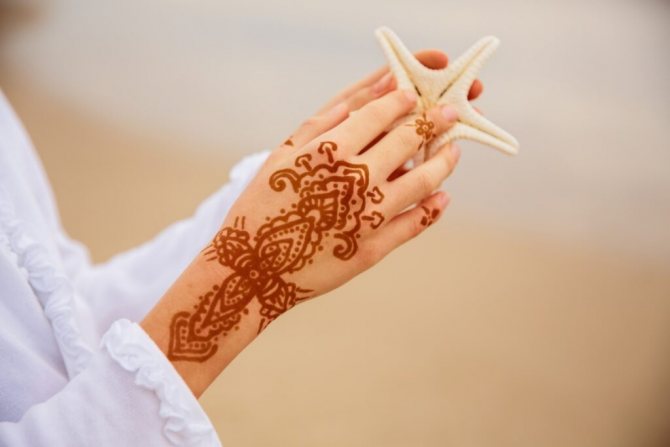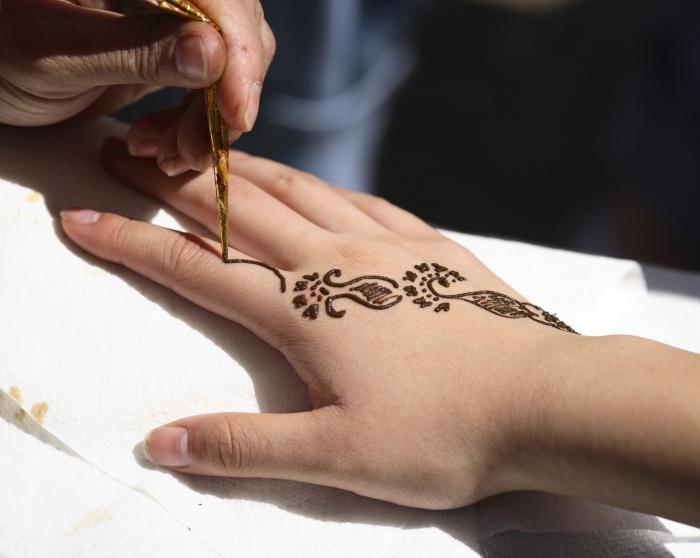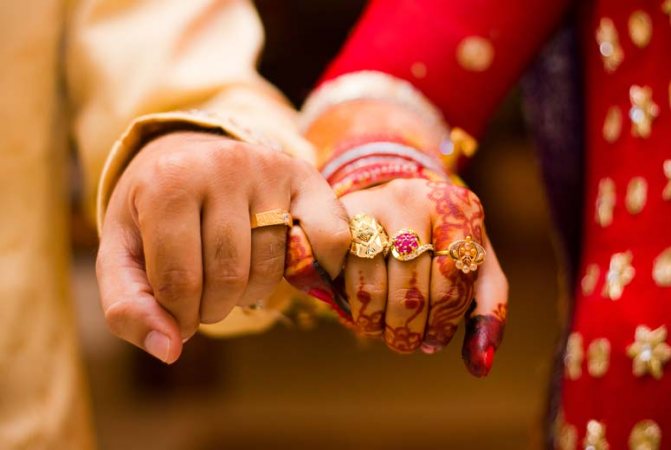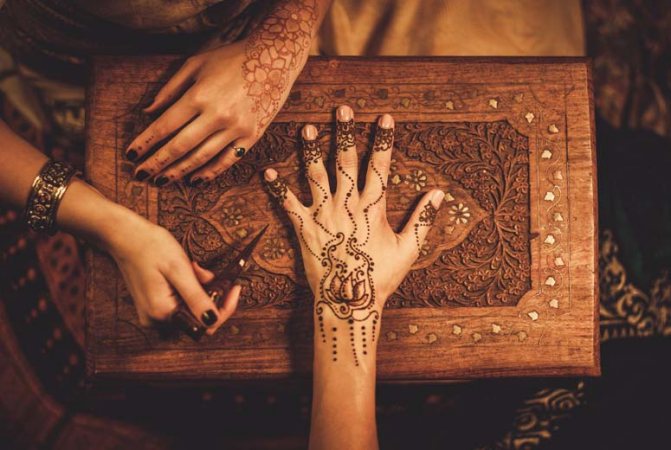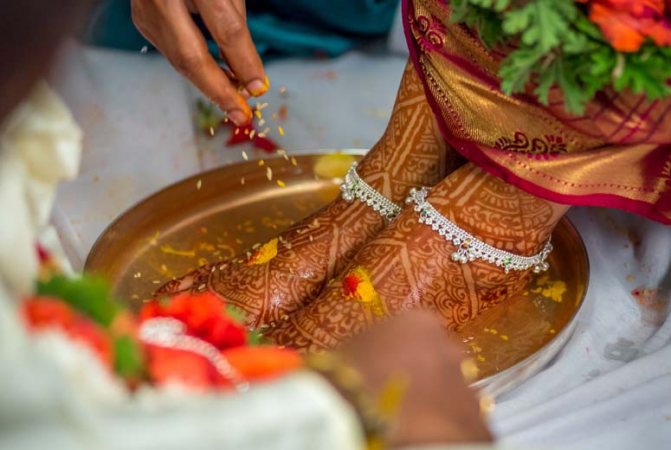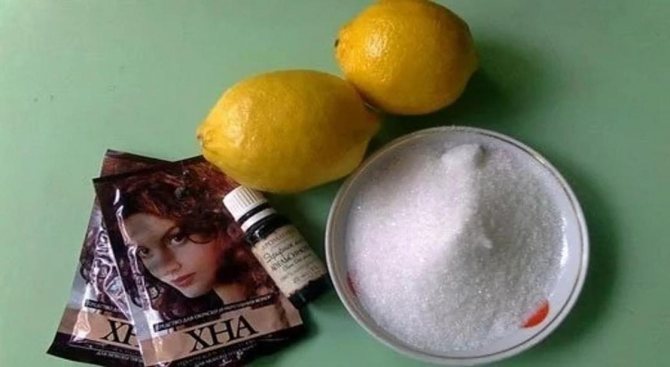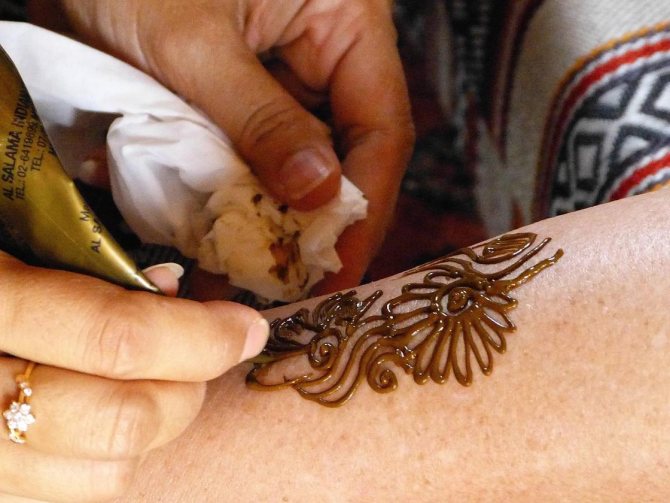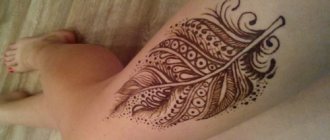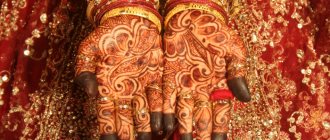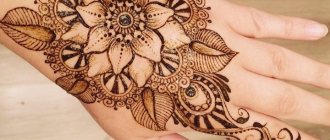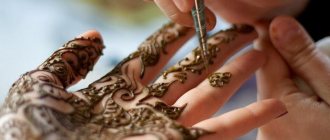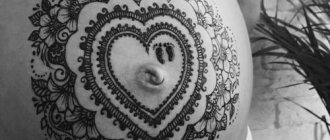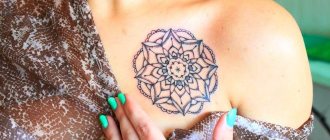Today we will tell you how long the mehendi lasts and what are some ways to make it last longer before the mendi wears off. The henna used to paint certain parts of the body has been known for 5,000 years.
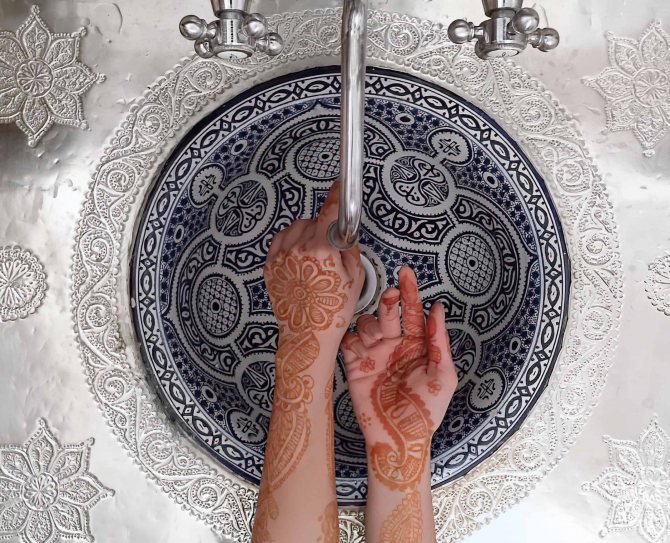
Women living in Ancient Babylon, Egypt, India and Greece decorated their bodies by painting on an arm or a leg, in order to protect themselves from bad luck, diseases and even death.
In addition, mehendi drawings were used to decorate women and men during wedding ceremonies.
Today, such patterns are applied not only in Eastern countries, but also in European countries, and, if in the first they are used for ritual ceremonies, in others - they are used as an exquisite decoration of the body.
What is used to make mehendi?
The paint, with the help of which drawings are applied, is made from a shrub called lawn. The leaves of this plant are gathered as soon as it blossoms, then they are grinded to a powdered state, resulting in the well-known henna.
The higher the leaves are on the shrub, the higher the coloring ability of the powder obtained from them. Such leaves are used to make powder for the body, and from the leaves growing below - the dye used for the hair.
Henna has a wide range of uses, it is used for:
- hair coloring;
- Drawing on the body;
- Treating the scalp;
- restoration of damaged hair structure;
- body care;
- preparation of medicines used in the fight against diseases of the skin, mouth, head.
There is a belief that mehendi on the hand is able to attract to its owner happiness, give love and successful marriage. Some are of the opinion that the drawing created on the body with henna, can purify the aura.
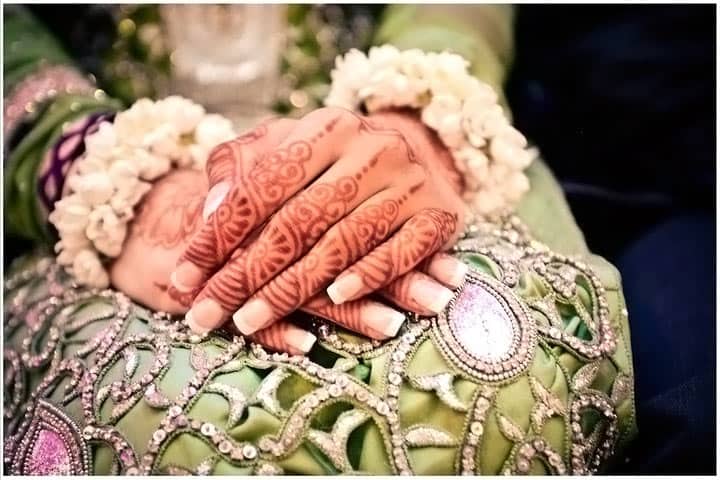

Is the temporary tattoo safe for the skin?
Externally, henna has the appearance of a green powder. It is the crushed young leaves of Lavsonia non-skinned. The resulting color of the tattoo depends directly on when the leaves are harvested. Only the opened leaves give a rich dark color. Older leaves color the skin in numerous shades of brown and orange.
If pure powder of plant origin is used as a coloring pigment, the likelihood of allergic reactions is very small. Also, a synthetic dye is mixed with the natural component. The resulting composition is considered harmless, but depending on your skin type, this paint can cause irritation, rash and redness. To understand, whether it is possible to do a henna tattoo to you, it is necessary to test the coloring substance on the sensitive areas: the knee-elbow bends.
Henna application techniques
Over many centuries of mehendi, as the art of applying henna to the body, stood out 4 styles, which have their own striking features.
- Moroccan styleThe Moroccan style was formed in North Africa. It is characterized by maximum clarity and geometricity of the applied pattern. The image, made in this technique, exactly repeats the form of hands or feet. The geometric figures created using this style have an ornament depicting flowers.
- Arabian style: repeats the traditional folk patterns, embroidery on fabrics, peculiar to Arab culture. The outlines in this style have no specific technique, their execution depends on the flight of fancy of the master.
- Asian style.: appeared in Indonesia, characterized by the presence of very bright and saturated colors. The pattern is concentrated on the fingertips and is painted in the form of flowers, framed as lace.
- Indian styleThis style is a very complex one. The patterns in this style cover a large surface of the body and look like a tulle or lace print.
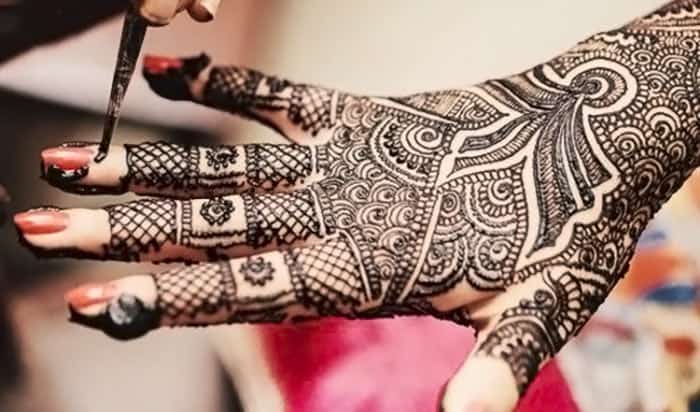

The process of henna application on the hand
Mehendi
Good afternoon readers!
I have written this article as an introduction, to briefly describe the process of making mehendi and to answer the frequently asked questions of my clients.
Art of mehendi appeared in Russia relatively recently, but is definitely gaining momentum and becoming a fashionable trend. Many celebrities decorate their bodies with temporary tattoos, often painting became popular with the brides. This decoration can be worn both every day and stand out on a holiday.
So, general concepts and frequently asked questions:
What is mehendi?
Traditionally, mehendi is a henna drawing on the body. The ornate patterns, interwoven with floral compositions, originating with a grain (bija), twisting into lace, and turning into a chic decoration of the arms, legs or other parts of the body. This art is more than 5000 years old and has been known since the time of ancient Egyptian funeral rites, which later developed into a body decoration art.
In the XII century the art of mehendi was firmly established in India and has become more than just a decoration. In India mehendi drawings have a certain sacred meaning and are used almost on all occasions. Especially traditionally, Indian women decorate themselves with mehendi on a long journey, on a date, on a holiday, and even on a job interview!
The ritual of applying mehendi to an Indian bride is especially different. For this purpose, the bridesmaids and their closest female relatives gather for a hen party, light agarbatti sticks, recite mantras, and spend hours painting the bride's hands and feet, invoking happiness in marriage, the faithfulness of her husband, many children, and additional advice.
What do you do mehendi?
At certain times of the year, on the plantations, begins collecting the top, young leaves of the lavsonia. This is the name of the plant from the leaves of which henna is made. This shrub grows in North and East Africa, India, Iran, Pakistan, Afghanistan, Syria, Kenya, Morocco and Australia.
The leaves are known to contain pectin and coloring substances, alhanin (green chlorophyll) and lavzon (yellowish red); and the flowers and seeds contain essential oils.
The young leaves, collected from the upper branches, have the most intense properties, and are used to make dyes for textiles and pastes for tattoos. The remaining leaves go into the production of hair dyes.
Tubes with henna paste
Useful properties of henna.
Henna has strong drying, disinfecting properties, and is widely used to treat wounds, stitches, skin diseases, and bone ailments. A solution of henna is said to have a soothing effect on acute inflammation and abscesses. It is used for fungal diseases. There is an opinion that the smell of henna relieves headaches and increases libido.
How long does the master draw mehendi?
The time depends only on the complexity of the work. The thinner the lace - the longer the master digs into it. On average, for a standard job, measuring 10x15 centimeters, it takes 30 minutes. For a festive decoration it takes about an hour.
With the wedding painting, everything is more complicated. The work can take up to two hours or even more. It is desirable to "copy" the drawing in advance. Meet the day before, discuss the work itself, its cost, and, of course, note the time.
Does it hurt to do mehendi?
If only it tickles! Mehendi is not a tattoo! Mehendi is a temporary drawing made with henna paste. It is applied in a thin layer to a skin area that has been degreased beforehand and left on until it dries. The dry residue is removed with tweezers or a dry napkin.
What color can mehendi be?
If mehendi is made with natural henna, as a rule, the color becomes chocolate brown (appears within ten hours).
If water colors are used, the color can be absolutely any.
Where can mehendi be applied?
Absolutely on any place of the human body!
The most frequent orders are arms, legs, back and abdomen.
How long does mehendi last?
Well this depends on the part of the skin where the picture is applied. For example, on the palms and soles of the hands and feet the drawing will last a long time, and on the back of the hand - much less.
Human skin is a self-renewing system, constantly freeing itself of dead cells that are constantly forming on the skin surface. New cells are born in the epidermis and move toward the surface of the skin as they mature. This process takes about a month. Once they reach the surface, they exfoliate and die off.
In other words, the coloring pigment of the henna penetrates the dying skin particles, colors them and stays inside until the particles die off.
My clients "wear" the jewelry for one to two weeks. On the back, you can manage to last a month.
As for wedding painting - again, an ambush! Wedding pictures do not live long! Three or four days at the most. Unfortunately. The drawing for the bride is not done in henna, and a special paint for body art, which does not last long. But, it is easy to wash off with water and a washcloth!
Is there an allergy to mehendi?
I usually ask my female clients to tell me about such cases, but I haven't had a single complaint yet. In general, if you think logically, there is no allergy there, if the master uses quality materials (and I use quality materials). To make a paste, cinquefoil powder is usually mixed with hot water and oil. Infused, cooled, and applied.
How to care for mehendi?
Before taking a shower, it is advisable to put oil on the drawing. A layer of grease will close the pores and protect the drawing from fading. Hot baths, saunas and baths should preferably be postponed until after the drawing begins to fade. The steam, on the contrary, will open pores, which improves the exfoliation of the skin and facilitates scrubbing the drawing.
Under no circumstances rub the drawing with lemon juice! Think about why a slice of lemon dipped in strong black tea makes it a straw color? That's right! Lemon is an acid that lightens any plant pigment.
Lemon can only be used to wash off the drawing.
How to remove mehendi?
The most difficult question. It is almost impossible to erase mehendi, but it is possible to weaken the color and make it less noticeable. To do this, it is desirable to sweat in a bath with brooms, or just steamed the body in a bath with scrubs. Not yet cooled, rub the picture with lemon juice and let it soak in. If there is a need to wipe it up to the end - use alcohol or acetone-based nail polish remover. Not the best option, of course, but from the desperation, and very occasionally, then you can. Yes, and nails, the same scrubbing with this liquid?
On top, reddened from scrubbing, the skin should be smeared with moisturizing cream. Usually, a few hours after this procedure, the picture disappears.
Disadvantages of mehendi.
The main disadvantage of this decoration is the inability to remove it easily.
The drawing may come off unevenly, leaving not very nice spots.
If the client accidentally smeared the drawing, it cannot be restored, because getting on the skin, the henna is almost immediately absorbed into the pores, leaving traces. It is possible to correct such a thing, but by changing the trajectory of the drawing.
As for Glitter - tattoos (sequins, rhinestones), it is easier to wear such jewelry. And it's also easier to wash off - wipe with a nail polish remover.
How much can mehendi cost?
From 500 rubles, the size of 10x15 centimeters (hand), to infinity.
What is a wedding painting?
Wedding painting is a new phenomenon in the wedding market of services. Avant-garde young people have picked up this trend and promote it as a way of self-expression.
Wedding murals are not only exotic, attracting attention, but also a means to disguise small defects in the exposed skin areas of the body and even the face. The drawing will successfully hide a tattoo or a scar. The work can contain both floral bouquets, the initials of the bride and groom, any butterflies or birds, and repeat the ornamentation of the wedding dress. The image is complemented with sequins and rhinestones, which makes the image airy and complete.
Thank you for reading all of this! Now it will surely be easier for you to make the decision to decorate yourself with these designs.
Cooking the paste
To create an incredible pattern on your own body, you need to prepare the paint. The quality of the drawing and how long the mehendi will stay on the surface of the body depends on the correct creation of this solution.
The standard recipe involves the use of the following ingredients:
- 0.5 l of hot water;
- 40 grams of natural henna powder;
- 2 tsp. ground coffee;
- 2-3 drops of tea tree oil.
The process of preparing the paint looks like this:
- Pour the powder into the water and put the mixture on the stove, on a low heat.
- After the composition boils, put the coffee in it.
- Thoroughly stir the lumps that form.
- Keep on low heat for at least 60 minutes.
- After turning off the stove, add the tea tree oil, which will make the color last longer.
- Infuse the paint for 3 hours in a darkened space.
A quality composition will have a medium thickness. The paint must not flow or be very thick, otherwise it will be difficult to achieve accuracy of application.
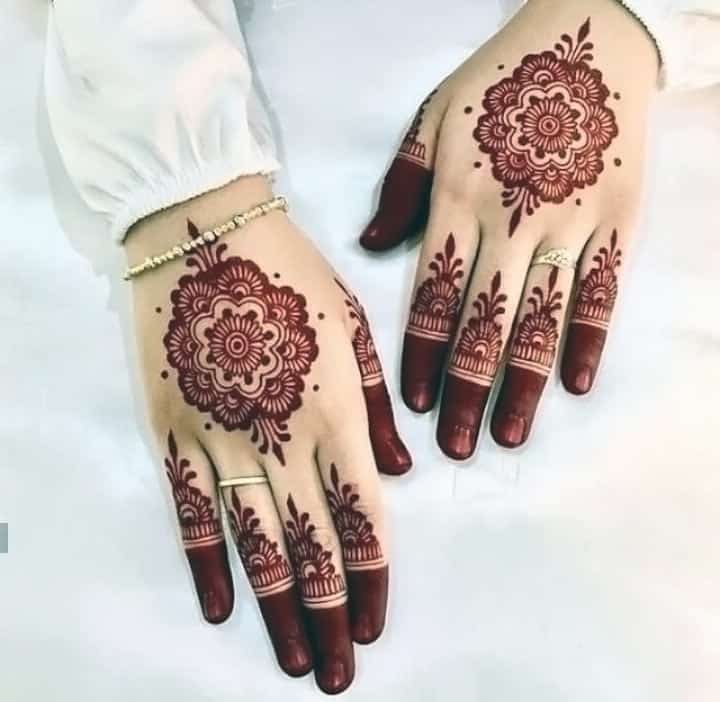

Step by step instructions: how to make a henna tattoo at home


by ladyzest
Before proceeding directly to the magic, that is, to the dilution of the paint, it is worth first understanding that coffee or tea does not give the henna a black hue, not at all. In fact, the depth of color can provide the acid, which you take from the juice of a lemon or lime, the more of it, the darker will be your drawing later.
Step one: how to dilute henna for tattoos
- Using a strainer, carefully sift a certain amount of henna into a pre-prepared bowl or a bowl.
- Squeeze the juice of one lime, or lemon. After straining it with the same strainer or a piece of gauze, mix the juice with henna powder.
- Make extremely strong coffee or tea. And the difference that take is not significant, both these drinks contain special tannins, which are required to create a quality color. Add the drink to the mixture should be very hot, and if it has had time to cool, it is better to pre-heat it well again, but not boiling.
- Mix coffee or tea with the prepared raw material and, having covered it with a cloth, leave it until the morning, so that the mixture could swell.
It is worth remembering
The mixture of henna prepared in advance, that is, the paste used to draw the patterns on the body, is not disposable and you do not have to throw it away. It can easily be stored for two to six days in the refrigerator, and even more, up to a month, in the freezer.
Step two: how to use henna for tattoos
After waiting for the morning and making sure that the henna paste is homogeneous and malleable, it is also worth giving it the right consistency. If in the evening it was too thick, you can slightly dilute it with lemon juice or the same, strong tea or coffee. Then it is necessary to make a small bag out of thick polyethylene or, even better, foil, making it into a bag similar to cake decorations. There and lay out our paste, and in the corner we make a puncture, no wider than a thick sewing needle.


henna.elements by flickr
- Experienced masters apply drawings and patterns "by eye", without using absolutely any preliminary sketches, but this is true "aerobatics".
- At the very beginning, when experience and practical skills are not yet available, it is worth using stencils, which are freely available or can be downloaded from the Internet and printed.
- Before drawing on the body, the place where it will be necessary to wash thoroughly with soap and remove all hair. The thing is that the paint can easily get absorbed into the hair, and it comes off the skin much faster than on the hair.
- Apply the drawing on the chosen place and leave it for about an hour. It is worth noting that the picture or pattern will be more intense if you hold the paint on the body longer.
- After the time has elapsed, the dried paste should be washed off the body, in no case using a washcloth or sponge.
After the procedure, you can wipe the drawing with some essential oil, it can slightly fix the drawing, moisturize the skin, and just smell nice. Usually wood oils are preferred, like sandalwood oil, but there is no limit and you can choose exactly what you like best.


kenzilicious by flickr


henna.elements by flickr


Akiyohenna by flickr


Nev


kenzilicious by flickr


rovinghorse by flickr
On which parts of the body to apply henna?
Before you paint the patterns on your body, it's a good idea to find the best place to place them. You can't just paint wherever you want, so it's best to think about all the options and make the right choice.
- The collarboneHere the pattern will look especially sensual, and this applies to women of all shapes. The design on the clavicle is always noticeable, so choose the design carefully.
- The forearmA good place for a star, angel or sakura sprig pattern. An important advantage of this part of the body is the ability to remove the pattern under clothing if desired.
- The ankle or calf muscle: A great area for summer, when short skirts, shorts and dresses are worn.
- WristsThe wrists: the perfect place to put your mehendi and the prints will last a long time because of the thinness of the skin, which is able to absorb the colors.
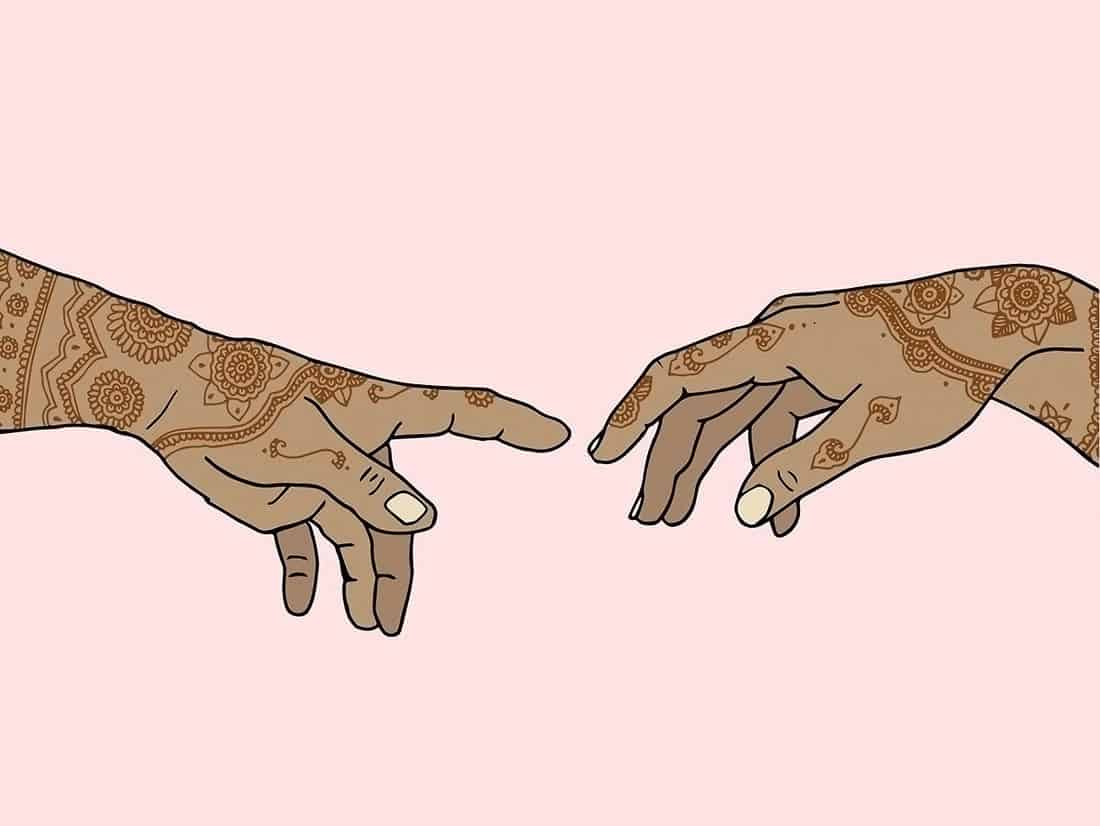

Mehendi. About henna painting on the body
Recently, it has become fashionable and stylish to apply mehndi (mendi, mehendi) - henna patterns and drawings on the body or, as they are also called, temporary bio-tattoo henna. All over the world salons are opening up for henna painting and application of mhendi (mehendi or Hindi) on the body. The fashion for mehendi came from eastern countries: India, North Africa, Malaysia and Indonesia. Patterns were applied for celebrations, weddings to protect themselves from misfortune and to attract good luck, prosperity, peace, to have children as soon as possible. You can see henna patterns on artists, movie and theater stars. For example, on Madonna, Demi Moore.
Interesting facts about mehendi
How to properly apply the drawing?
In order for the drawing to last as long as possible, mehendi should be applied only after the preparations have been made:
- steaming the area of coloring, necessary to open the pores, which after this procedure will easily absorb the dye composition;
- cleansing the skin from surface impurities using a special detergent;
- removal of dead skin particles using peeling or body scrubbing products;
- Degreasing the selected area with products containing alcohol.
Mehendi patterns are drawn with a special thin brush, stick or a device that looks like a pastry cream bag.
The thinner the lines that make up the pattern, the more exquisite and beautiful the result will look.
The procedure for applying mehendi is quite simple, to do it yourself need to have minimal drawing skills:
- Apply the stencil of the future drawing on the skin.
- Draw the borders of the pattern with a felt-tip pen or a thin brush dipped in henna.
If a line or pattern is missed during the process of drawing, you can always wipe the unsuccessful section with a cotton swab soaked in alcohol.
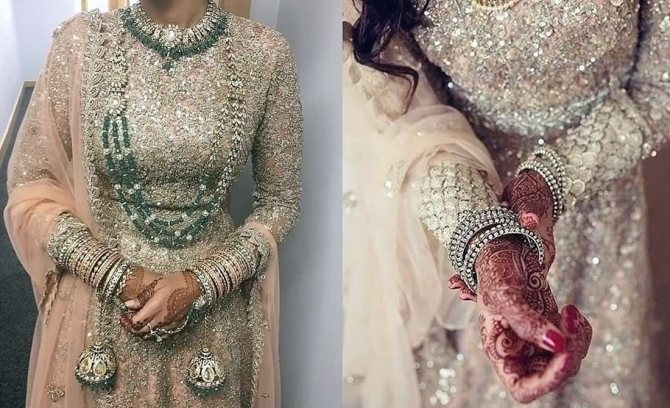

How long does the tattoo last?
A temporary henna or "mehendi" tattoo can be done at home. To do this, you need to buy the henna itself in a tube or a soluble mixture, stencils, base vegetable oil. Stencils help to apply the traditional pattern, which is very useful for beginners. Instead of overlapping stencils, you can use stamps and seals, but this approach will not make a henna tattoo durable, so a tattoo applied with a stamp, unlike a conventional one, will not last more than a week.
It is not necessary to apply a symmetrical pattern. Often a small graceful pattern with a clear asymmetry looks much more interesting.
How long does henna dry on my hand?
After applying the henna pattern on the surface of the body, it must be dried thoroughly. This will take at least 1 hour, but ideally henna dries for at least 8-9 hours. If the composition dries completely naturally, its colors will be very bright and saturated.
You can dry henna both naturally (outdoors, under the sun) and artificially, using a hair dryer. However, staying 8 hours in one place or exposure to hot air on the skin, is impossible.
To facilitate the process of drying henna use:
- Food film, with which they wrap the surface of the body, with the pattern applied to it;
- hairspray with a strong fixation, sprayed on mehendi (in this case the additional use of polyethylene film is shown).
How to make a henna tattoo at home: step by step instructions or how not to do something stupid


Marji Lang by flickr
It is clear that the master in the salon is engaged in a similar practice, by default, not the first time, and also has the appropriate education, if I may say so. That is, a certain level of training and some artistic skills are offered. But in order to become the happy owner of a henna tattoo it is not at all necessary to address to the master in the salon, and though its cost is ten times less than the usual, nevertheless it is possible to do everything and independently. It is enough to buy everything you need, that is, a powder or ready-made henna paste, and then carefully study the instructions on how to do a henna tattoo at home.
First things first: the selection of materials and equipment
To the question of where to sell henna for tattoos there are several answers, which are simple and straightforward. First of all, to buy the powder itself, which requires special preparation, or already prepared paste, you can in specialized stores, good thing, the modern market offers many options. In addition, you can also look at the henna in numerous online stores, where the choice is simply colossal, and the cost of the product can be many times less.


The question of price is also of interest to many people, especially in view of the difficult economic situation. How much does henna cost for tattoos in the cities of our country to learn at all is not difficult, it is also possible to find an answer on the Internet. And the price ranges between two or three dollars, not higher, and in practice, the cost does not exceed a hundred or two rubles, which is not so much. How much henna for tattoos costs also depends on which company it is made by and where it is shipped from, because if you order it from, say, one of the Indian portals, you may pay more for shipping than for the product itself.
- Singh Satrang is a henna straight from India, which is of quite high quality, but its color varies exclusively among the shades of brown. It takes about twenty-four hours for the henna to show through, so you will have to be patient.
- Golecha is just the thing to buy if a tattoo is needed urgently. It is applied simply, the color is bright and saturated, and twenty minutes later you become the happy owner of a beautiful design that will last five or seven days.
- Kaveri is also a product from warm India, and is highly appreciated by experienced mehendi masters. This is a weighty factor to choose, in addition, it has a bright color and lasts up to two weeks.
- Neha - at this time it is considered the best and most durable henna. This henna contains only natural components, that is, it can not cause allergies. However, the pattern appears after a day, and it will be really saturated only after two or three days. Such a pattern lasts for more than two weeks.


The mehendi by tattookit Synaa
Among other things, if you decide to take the powder and dilute it yourself, you will need to acquire special tools and devices:
- The powder itself henna, and it should be understood that only one tablespoon will be enough to decorate the hands of six people.
- Steel alloy or wooden spoon for stirring.
- A strainer to sift the powder.
- A bowl or a bowl for mixing ingredients, preferably ceramic or glass, which makes it easier to clean after use.
- A couple of limes or lemons.
- Essential oils if you want to make the color more persistent and saturated, and the procedure pleasant.
- A few spoons of steeped coffee or tea.
What to do immediately after the procedure?
After the deadline for drying the paste is met, it should be carefully removed from the surface of the skin. For this purpose, a scraper, which can be purchased in professional cosmetics stores, or the blunt side of a knife, a toothpick or your own medium-length nails are excellent.
In cases where the henna does not come off well, you can additionally treat such areas with vegetable oil, most importantly, do not put water on the drawing.
After removing the paint, experts recommend treating the entire pattern with almond oil, which will saturate the colors with bright hues and give the figure a shine. If you apply eucalyptus oil to the skin, you can achieve a darkening of the main shade.
In order for the mehendi to last as long as possible, the following rules should be adhered to for the first time:
- Keep the painted area away from water for at least 4 hours, and ideally 24 hours after applying the pattern.
- Keep the pattern out of contact with water as little as possible.
- Do not wash off henna residue from the skin with water, so as not to damage the surface structure of the skin.
- Apply special oils to the skin to help consolidate the result.
If you follow all the rules, then 2 days after the application of henna, mehendi will change the original brown color to a rich dark chocolate color.
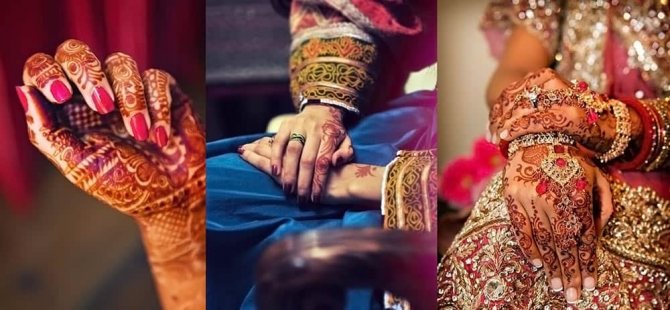

Distinctive features of body dyes
Several varieties of dye compositions are used for artistic skin decoration. The original mendi, which came to our country from the East, uses henna powder. It is obtained by processing the dried leaves of the tree Lausonia non prickly. This natural material contains a persistent pigment that stains the dermis. This property of leaves was already known to the Kings and Queens of ancient Egypt, Indian tribal leaders and Syrian beauties. The secrets of the coloring paste have been handed down from generation to generation for 5,000 years. In India, every family has a secret recipe that only their closest relatives know about. It is used to paint the bodies of girls on the great national and religious festivals and on the day of marriage. The bride's hands, feet contain images with messages for a happy life and prosperity.
In Europe, henna body painting is of a different nature. Here they do for personal reasons, and more often because of fashion trends. The tattoo comes in many colors or traditionally brown. How long the mendi will last for 90% depends on the color scheme.
A permanent pattern is one drawn with natural paste. The henna contains coloring micro granules, which, under favorable conditions, penetrate the cells of the epidermis and lasts for 2-4 weeks.
To mehendi held much longer it is treated with oils and protected from friction, water and other negative factors.
But Europeans prefer to do temporary tattoos in accordance with the eternal tattoo, that's why they often choose black shades for them. This ornament looks expressive, but causes a lot of side effects. First, the composition of the dye often contains chemical elements that cause burns or allergic skin reaction. The consequences are associated with health problems, sometimes leaving scars. Secondly, the relative fragility of the pattern. How long will a mandy in black last? Up to 1 week. This is an artificial paint, in which they rarely add even a drop of henna.
A white tattoo is an original decoration for celebrations. Today you can use such tattoos to complement the image of the bride. They are drawn on the legs and arms, like stockings or gloves. How long does the white paint last? One day. It will not erase from the touch of guests and the embrace of the beloved man, but one bath or shower is enough to wash off without a trace.
Colored pattern is created by artificial substances, so its life span is short, although bright.
What does the longevity of the pattern depend on?
To answer the question of how long mehendi lasts, you should consider the varieties of this paint. The natural composition is able to hold up to 21 days, and the colors created on the basis of henna powder - about 5 days.
The longevity of the applied pattern is influenced by the following factors:
- Placement of the pattern: mehendi lasts longer on areas with rough skin, on the feet or palms;
- The soaking time of the composition on the skin: ideally, it should be at least 8 hours;
- tattoo care procedure, which includes limiting contact with water, avoiding exercise with profuse sweat and obligatory oiling of the painted area;
- skin type: tattoos last longer on dry skin;
- Your skin type: darker skin tone means your mehendi will last longer.
The type of henna also affects the longevity of the resulting drawing. Mixing natural powder with basma (needed to create a darker shade) shortens the longevity of mehendi to 4-6 days.
White henna (which does not contain natural powder), which gives minimal allergic reactions, lasts on the skin for no more than 2 days.
On average, henna applied to the soles of the feet or palms can hold up to 3 weeks, and the patterns on the hands or feet - no more than 2 weeks. Therefore, additional removal of the mendi is not required.
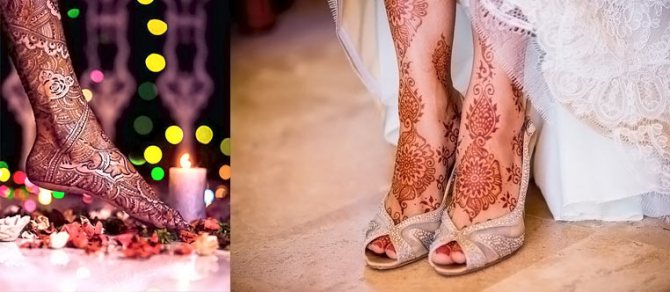

Mehendi on Feet
How to dilute henna for tattoos?
The beauty and quality of the tattoo directly depends on the quality of the paste, so it is better to stick to the recipe for its preparation. It is recommended to start preparing the paste in advance, because it takes 24 hours to fully cook the paste.
Henna drawings on the hand
What to prepare:
1. Henna powder (20 grams - 1 tbsp. tops). This is enough to paint both hands up to the elbow. 2. Lemon juice (freshly squeezed and strained from 2 lemons). 3. Sugar - 1 tsp. 4. Various aromatic oils. 5. A small glass or plastic mixing bowl. 6. A fine strainer. 7. Scoop measure. 8. Plastic bag.
Applicator tools of your choice: brush, toothpick, regular medicine syringe without needle, small plastic bottle with hole. You can make your own syringe doll from a bag with a small hole. For wide drawings, you can take an ice cream stick.
In the evening in advance:
Sift the henna through a strainer. If you have chosen a picture with thin lines, and you are going to draw it with a syringe, then you need only a homogeneous paste without lumps. You can also wipe the mixture afterwards through a fine strainer.
About one day before drawing, pour the henna into a container and add 1/4 cup of lemon juice. Mix everything until a homogeneous mass without lumps. The consistency of the mixture should resemble mashed potatoes. Wrap the bowl tightly in a bag, to prevent the air to get in, and leave it for 12 hours in a warm place (about 22 - 25 ° C). You can also heat the mixture gently in a water bath.
Henna drawings on the hand
It is impossible to dilute henna with ordinary water, because you need an acid environment to obtain the coloring pigment. There are recipes in which, in order to obtain a darker color paste, add more coffee or spices.
But this does not have to be done. Fresh lemon juice and fragrance oil are quite sufficient. For a darker color, add a little basma to the paste.
Do not add any other ingredients to the paste, they can either themselves or after reacting with henna, cause an allergic reaction!
The next morning:
Add 1 tsp. sugar to the mixture. Mix thoroughly. Sugar is needed to make the mixture stick better to the skin. You can (if desired) add 1 tsp. scented oil.
It is better to take - oil of orange or tea tree, lavender, eucalyptus, sandalwood, clove oil. A mixture with essential oils gives a more stable result and the pattern turns out darker.
If the paste is very thick (then it will be difficult to squeeze out of the applicator), it must be diluted with lemon juice. Add 1 tsp. spoonful and mix well until you get a consistency like toothpaste or thick sour cream.
If the paste is liquid (the pattern will flow), add a little henna powder. Now wrap the bowl in a bag again and leave it in a warm place for 12 hours. Congratulations, the paste is now ready!
Hand henna drawings
How to keep the pattern for a long time?
To extend the time to enjoy the beauty of the mehendi that you have spent time and money on, a few simple rules should be followed:
- Avoiding contact with water, especially in the form of visits to the sauna or baths, pools with chlorine and the salty sea.
- The use of protective gloves and special products during washing (if the mehendi is on the hands).
- Taking care of the tattoo, which means not rubbing it on clothing or bags.
- Wearing loose fitting clothing that allows the skin to breathe and the design not to come into contact with the sweat.
- Prohibiting the use of a washcloth while showering (on the area where the pattern is located).
- Careful attention to skin care products, if they contain alcohol, it is forbidden to use such substances on the skin with mehendi.
- Constant moisturizing of the drawing surface, allowing to slow down the processes of dying off of old epidermal cells.
- Avoiding creams that have a bleaching effect.
Are there any alternative ways of applying temporary tattoos
Recently, temporary tattoos for 3 months or several years have become popular. This type of tattoo is called tempu. They are applied with special and, as the masters claim, sparing dyes that lighten with age and disappear altogether. How does it happen in practice? Your tattoo will have a tiny diameter of up to 5 cm and a minimal set of colors. Over time, the paint will begin to fade, but not completely, and will leave a "memory" of itself in the form of a vague spot, similar to a bruise.
Henna is the only long-term method of applying temporary tattoos. There are no alternative ways, and the salons, offering the service of temporary tattoos for a period of 3 months, are charlatans.
